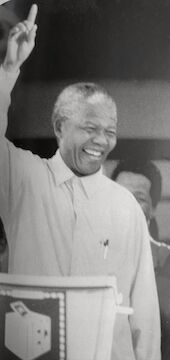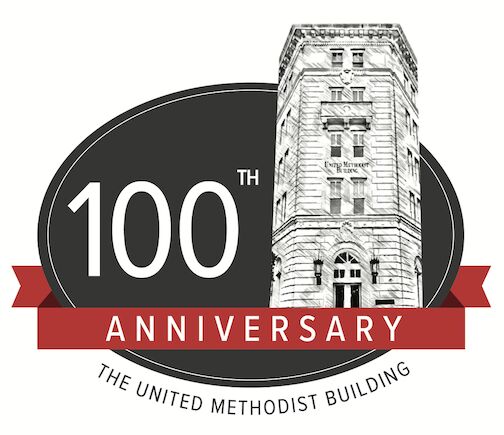ON THIS DAY... South Africans At United Methodist Building During National U.S. Anti-apartheid Tour
On April 3, 1986, a distinguished delegation from South Africa held a press conference at The United Methodist Building calling for U.S. support to end apartheid in South Africa.

From inside The United Methodist Building, The Rev. Abel E. Hendricks, the former president of the Methodist Church of Southern Africa, alongside Freda Hendricks, Rev. Theodore Coggin, The Rev. M. Stanley Mogoba and Rev. Andrew M. Losoba addressed the media to highlight the violence and genocide carried out by the South African apartheid regime.
To help dismantle apartheid, the five member South African delegation traveled across the United States to push for economic sanctions, basic freedoms and human rights, especially for political prisoners, including Nelson Mandela. Mandela had been under a life in prison sentence since 1962 for his leadership in resisting apartheid.
Apartheid had been the law in South Africa since 1948. Racial stratification dictated where people could live, work, and go to school. By 1959, black people were removed from certain areas and forced to live in townships where they were not allowed to own land, but only rent it. Resistance came in the form of strikes and acts of civil disobedience; the law enforcement response to these protests was swift, brutal and deadly.
Methodist Response
As early as 1948, the Board of World Peace, a predecessor body of the General Board of Church and Society, called for the end of apartheid in South Africa. In 1968, the Methodist Board of Missions divested its $10 million investment portfolio from First National City Bank to another bank that was not directly involved in a credit arrangement with the Republic of South Africa. By the mid-1980’s, apartheid in South Africa had reached a global audience and the pressure for economic sanctions was mounting.
In the winter of 1986, Churches’ Emergency Committee on South Africa (CECSA), a group of 24 major churches, including The United Methodist Church and 12 interchurch agencies, sent a telegram to ten U.S. bank chairmen calling an end “to the evil system of apartheid”.
The United Methodist Church signatories of the telegram included Bishop James Mase Ault, President, Council of Bishops, Dr. W. Astor Kirk, Treasurer, General Board of Church and Society, and Dr. Isaac H. Bivens, Assistant General Secretary Africa and Europe, Board of Global Ministry.
While banks had already ended making any new loans to the South African government directly, many banks implemented bank-to-bank lending as a “back door” approach to funding the South African government. CECSA urged U.S. banks to cease renewing or making new loans to South African banks, and to refuse to reschedule debt repayment totaling 13.6 billion U.S. dollars, unless there was a change in the South African government to represent all people of South Africa.
In March and April of 1986, U.S. banks proceeded with rescheduling the debt repayment. In addition, banks including Banker’s Trust, the Bank of Boston, the Mellon Bank, and Wells Fargo developed new policies suspending any new loans to South Africa, private or public.
Congressional Action and Church and Society Activism

In the summer of 1986, Secretary of State George Shulz, (left) and Assistant Secretary of State Chester Crocker from the Reagan Administration, offered testimony during congressional hearings over the imposition of U.S. economic sanctions against South Africa.
In the fall of 1986, just a few months following the South African five member delegation tour in the United States, Congress successfully passed the Comprehensive Anti-Apartheid Act of 1986, overriding President Ronald Reagan’s veto of the bill. The bill imposed economic sanctions on South Africa by the U.S. government and banned the South African airline, South African Airways, from operating in the United States.
Years after the 1986 United Methodist Building press conference, The United Methodist Church continued to push for economic measures against apartheid.
In May 1987, forty-five staff members of GBCS requested that their pension funds be held in escrow as a protest against the United Methodist Church’s continued investment in some companies doing business in South Africa.
Economic boycotts were endorsed at a denominational level. In April 1988, the Boards of Global Ministries and Church and Society endorsed the boycott of Shell Oil to protest the company doing business in South Africa, and the 1988 General Conference followed suit.
South African Apartheid System Defeated

Finally, after years of international pressure, South Africa began to see change. Under the new leadership of Prime Minister F W de Klerk on February 11, 1990, Nelson Mandela was released from prison after 27 years. Freedom of the press and freedom of speech were re-instated and a ban on black liberation movements was lifted.
In a historic 1994 democratic election, Nelson Mandela was elected as South Africa’s first black president. Mandela seen here casting his vote in South Africa’s first general election (photo credit: Peter Magubane and Library of Congress)
United Methodist Building Anniversary Resources
To watch four new United Methodist Building video shorts “Celebrating 100 Years of Social Witness,” and for information on the year of celebration click here.

To purchase the 2024 United Methodist Building historical book written by Dr. Jessica M. Smith, For Justice and Enduring Peace: One Hundred Years of Social Witness, visit Cokesbury Publishing.
ON THIS DAY SERIES… Each month in 2024, Church and Society will highlight notable days offering glimpses into the momentous 100-year history of the United Methodist Building and the people called Methodists often walking along side ecumenical partners living their faith through social witness.